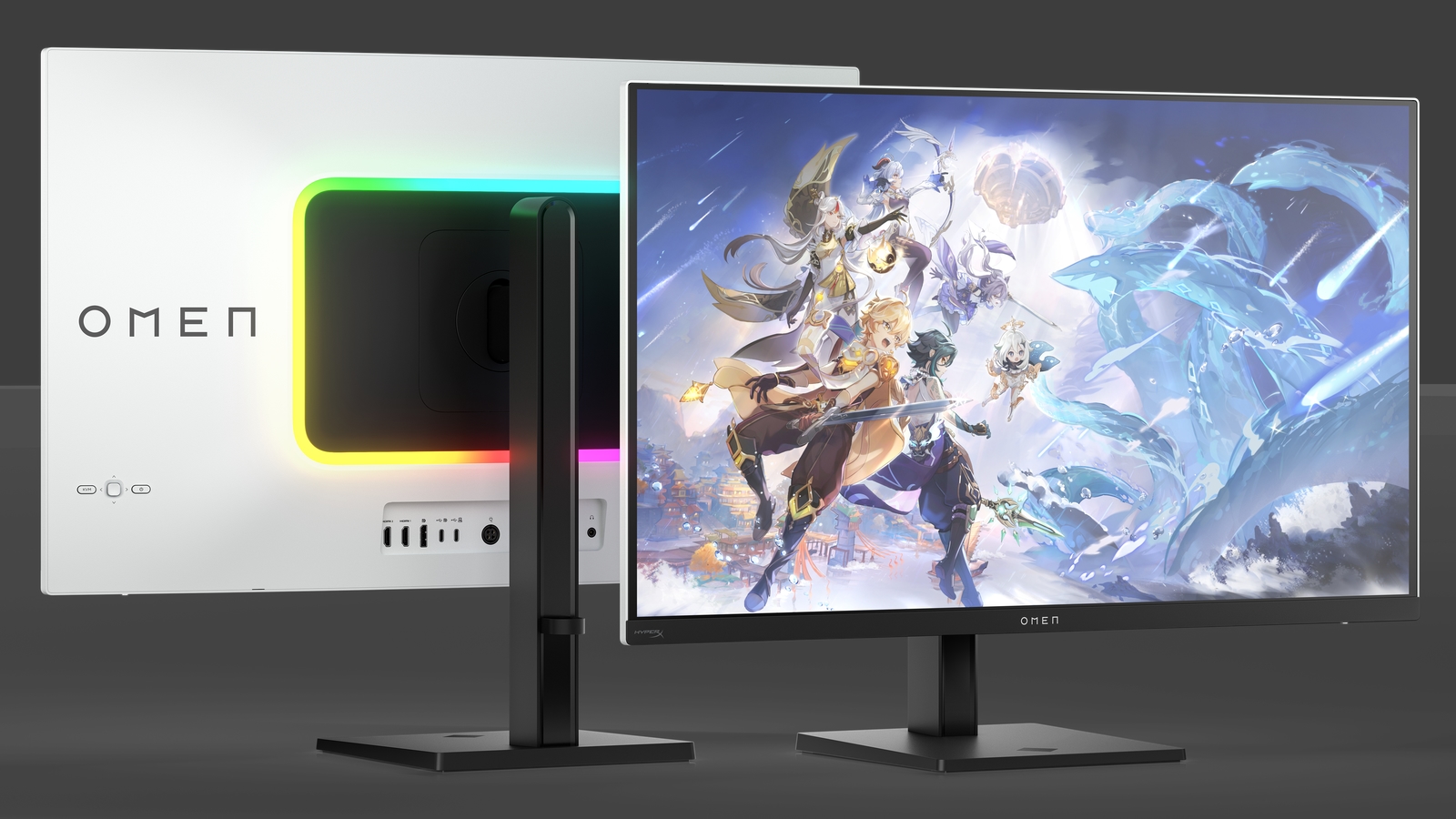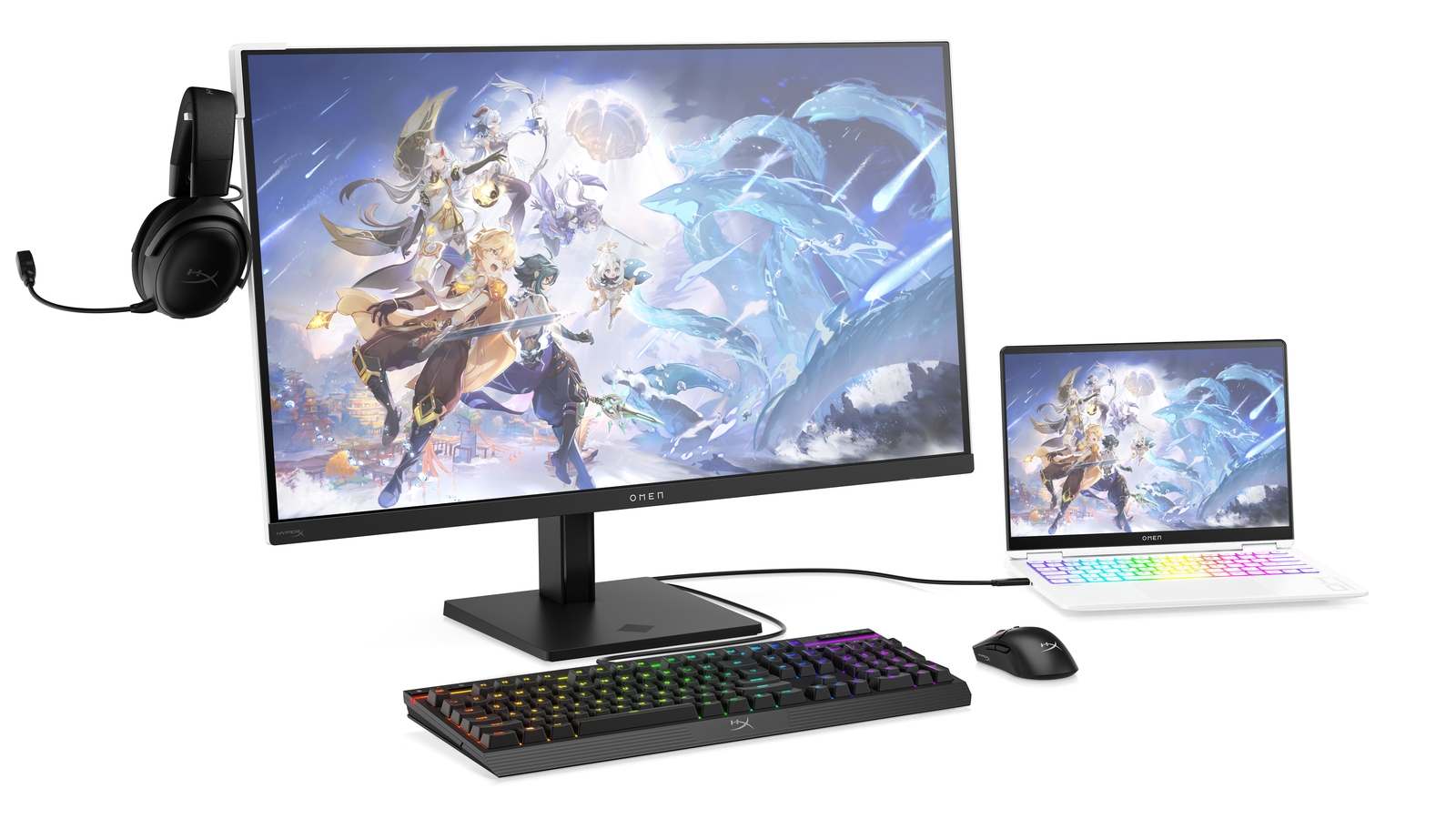HP launches Omen Transcend 32 – 240Hz and 4K in a 32-inch OLED gaming monitor
HP claims several "firsts" with its new Omen Transcend 32 gaming monitor.

Hewlett-Packard has unleashed a slew of gaming PCs and peripherals at CES, and one of the most exciting entries is the new Omen Transcend 32 gaming monitor. The company claims that the Omen Transcend 32 achieves several "firsts" in the industry, including the assessment that it's the first gaming monitor with audio "tuned by HyperX," which is a little self-serving.
HP also claims that this is the first gaming monitor with independent switchable USB ports and the first OLED gaming monitor with 140-watt USB-C Power Delivery, which should be more than enough to fuel the most demanding gaming laptops.
But first and foremost, the Omen Transcend 32 features a 32-inch QD-OLED panel with a 4K (3840 x 2160) resolution, 240Hz refresh rate, and a 0.3ms response time. As you might expect from a high-end gaming monitor, the Omen Transcend 32 supports AMD FreeSync Premium Pro, and we suspect that it's also Nvidia G-Sync compatible.
HP says the monitor is VESA DisplayHDR True Black 400 certified and supports Dolby Vision for improved image quality. However, typical SDR brightness for the panel is rated at 250 nits, while maximum output with HDR content tops out at 1,000 nits. Likewise, you'll find 99 percent DCI-P3 and 100 percent sRGB coverage with this QD-OLED panel.
Since the Omen Transcend 32 is geared towards a gaming audience, you won't be surprised to find configurable aRGB lighting that illuminates a rectangular section on the monitor's rear. HP also employs OMEN Tempest technology to cool the OLED panel (thus preserving panel longevity) during intense gaming sessions.
Regarding connectivity, the Omen Transcend 32 doesn't disappoint. It comes equipped with two HDMI 2.1 ports and one DisplayPort 2.1 port. There are also two USB-C upstream ports, along with one USB-C 3.2, three USB-A 3.2 downstream ports, a 3.5mm audio jack, and quad 3-watt speakers.
There's also a detachable stand for your headphones when not in use and built-in KVM functionality with independent switchable USB ports. To find the perfect ergonomic viewing angle with the Omen Transcend 32, it's adjustable for height, tilt, and pivot.
Get Tom's Hardware's best news and in-depth reviews, straight to your inbox.
HP hasn’t announced pricing for the Omen Transcend 32 and only says that it will launch later this year.

Brandon Hill is a senior editor at Tom's Hardware. He has written about PC and Mac tech since the late 1990s with bylines at AnandTech, DailyTech, and Hot Hardware. When he is not consuming copious amounts of tech news, he can be found enjoying the NC mountains or the beach with his wife and two sons.
-
rabbit4me2 Thanks for this article bro. For those of us who cannot truly stand a curved monitor and needed a 32-in size this might actually be the answer. But usually with HP there is always a catch somewhere we should seeReply -
bramahon I'd be interested in knowing if this one employs a 2nd-gen QD-OLED from Samsung. The peak brightness suggests it's probably not but I could be mistaken. Apart from having a higher peak brightness which boosts specular highlight in HDR, 2nd-gen QD-OLED panels are supposed to be more durable which likely is a bigger concern for people like me who're on the fence about OLED adoption. Anyway, the more the competition in the 32inch 4K segment the better it's for the consumer, so let those come in volumes!Reply -
Integr8d Reply
Any idea what the story is on auto-dimming? I bought one of the large Gigabyte OLEDs and ended up turning it into a TV display b/c the dimming basically meant I couldn’t edit photos. Pretty sure I couldn’t even calibrate it b/c the panel would dim as the color patches were cycling through.bramahon said:I'd be interested in knowing if this one employs a 2nd-gen QD-OLED from Samsung. The peak brightness suggests it's probably not but I could be mistaken. Apart from having a higher peak brightness which boosts specular highlight in HDR, 2nd-gen QD-OLED panels are supposed to be more durable which likely is a bigger concern for people like me who're on the fence about OLED adoption. Anyway, the more the competition in the 32inch 4K segment the better it's for the consumer, so let those come in volumes! -
bramahon Reply
Well, if it's about ABL (Auto-Brightness Limiting) then ya, those 1st-gen panels are pretty aggressive in this regard. This is why content creation is often a no-go on OLEDs, a shame really considering the wide gamut and color accuracy. It seems the 3rd-gen QD-OLEDs and 2nd-gen MLA W-OLED can sustain a higher brightness(~300nits) at a 100% window which may result in a less aggressive dimming algorithm. Depends on actual implementation from the vendor too, e.g. Corsair going with a dimmer Xeneon 27QHD240 (w/ burn-in warranty!) while ASUS ROG Swift OLED PG27AQDM is brighter -both using the same panel from LG. Let's wait for these new 4k 32" panels to come out and see how they fare as full fledged productivity monitors.Integr8d said:Any idea what the story is on auto-dimming? I bought one of the large Gigabyte OLEDs and ended up turning it into a TV display b/c the dimming basically meant I couldn’t edit photos. Pretty sure I couldn’t even calibrate it b/c the panel would dim as the color patches were cycling through.

